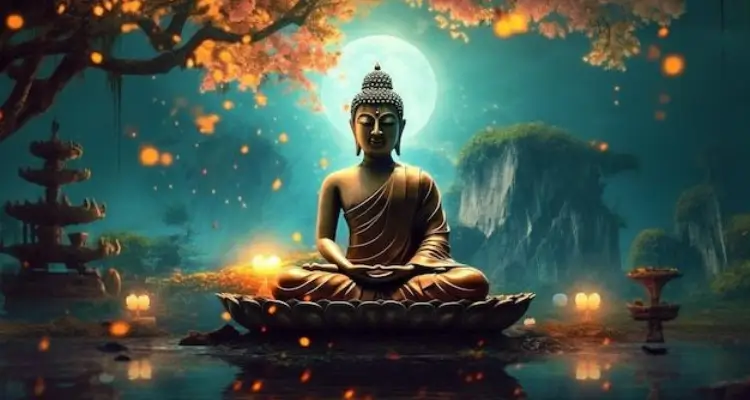The concept of Emptiness, or shunyata in Sanskrit, holds a central place in Buddhist philosophy. It invites us to reflect on the nature of reality and to realize that all things are empty of a fixed and permanent “self.” Emptiness teaches us that nothing exists independently, but everything is interconnected, in constant flow and change. By understanding Emptiness, we can dissolve the illusion of a separate “self” and recognize the universal interdependence that connects us to all forms of life.
The idea of Emptiness was deeply developed by Nagarjuna, a great Buddhist master who lived approximately 500 years after the death of the Buddha. He formulated Emptiness as a response to the fundamental question about the nature of the “self.” For Nagarjuna, the illusion of a permanent and independent “self” is the root of human suffering, and the true understanding of Emptiness leads to liberation. His work profoundly influenced Buddhist thought, particularly in the Mahayana tradition, where Emptiness is seen as the key to overcoming suffering and ignorance.
Emptiness is essentially the absence of immutable substance or identity in all things. It is directly related to the notion that nothing possesses a fixed or separate essence. Everything that exists is the result of mutual interactions and dependencies. At its core, nothing has an independent or inherent existence, and all things are empty of permanent nature. Thus, the concept of Emptiness helps us see beyond appearances and recognize the transience and impermanence of everything around us.
Rather than a worldview based on separation and fixed identity, Emptiness leads us to a deeper, more fluid understanding of reality, where all things are interdependent and interconnected. By exploring this concept, we can begin to dissolve attachment to the “self” and pave the way for a more conscious life in harmony with the natural flow of the universe. In this article, we will explore in more detail what Emptiness is, its implications for everyday life, and how it can help us live with greater wisdom and compassion.
The Concept of Emptiness in Buddhism
In Buddhism, Emptiness, or Shunyata in Sanskrit, is a fundamental concept that reflects the idea that all things are empty of a fixed and permanent “self.” Emptiness teaches us that nothing has an unchanging, independent essence. Instead of viewing the world as made up of separate, self-sufficient entities, Buddhism proposes a perspective where everything is in constant flux and change. The idea that things have their own inherent nature is an illusion, as in reality, everything is interdependent.
Emptiness is closely tied to the principle of interdependence, which states that everything exists because of something else. Nothing exists by itself, and everything is the result of interconnected causes and conditions. For instance, a tree can only exist due to the soil, water, sunlight, and other factors. This interdependence is a central characteristic of Emptiness: nothing has independent existence, and all things are deeply and intricately connected.
This view leads us to understand that the universe is an interconnected system in which all phenomena are in constant interaction. The concept of Emptiness, therefore, does not refer to literal or physical emptiness, but rather to the absence of an immutable and separate identity in all things. Instead of seeing objects, people, and events as isolated entities, Buddhism teaches us to perceive reality as a continuous flow where interactions and changes are the norm, not the exception.
Emptiness, as a worldview, offers a way to look at reality with greater depth and wisdom. It challenges us to see the transience and interdependence of all phenomena, helping us to live with greater acceptance, compassion, and less attachment to the idea of a fixed and unchanging “self.” By understanding Emptiness, we can develop a broader and more connected perspective of reality, in harmony with the natural flow of the universe.
The Illusion of the “Self”
In Buddhism, the concept of the “self” is fundamentally seen as a mental and illusory construct. The idea of a fixed and permanent “self” is fueled by memory and the sensation of continuity that our mind creates over time. We tend to identify with this sense of continuity, believing that we are the same being from yesterday, from years ago, or even from a decade ago. However, Buddhism teaches that the “self” is, in fact, a collection of memories and experiences that we are constantly reconstituting, without an immutable essence.
The persistence of this illusion of the “self” is deeply connected to the human fear of its own non-existence. The “self” seeks stability, wants to remain fixed and unchanging because it fears disappearance. This fear generates an intense attachment to identity and the concept of permanence, leading many people to believe that the “self” is something that must be preserved or that it must survive beyond death. However, Buddhism reveals that this “self” is just a temporary construct, not something fixed or eternal.
Although it is an illusion, the “self” plays an essential role in our everyday life. We need it to navigate the world, make decisions, interact with others, and function in society. Without the idea of the “self,” our life experience would lose coherence. However, it is crucial to understand that this “self” is not something definitive, but rather a transient phenomenon, dependent on external causes and conditions. Buddhism teaches us to recognize the illusory nature of the “self,” allowing us to live more fully without the constant attachment to our fixed identity.
Ultimately, understanding the illusion of the “self” helps us to release the fear of death and change, enabling us to embrace the impermanence of life and live with greater inner peace. By realizing that we are a continuous flow of experiences, not an immutable entity, we can transcend the limitations of the “self” and access a deeper understanding of our true nature and our interconnectedness with the universe.
Interdependence and Flow in the Universe
Emptiness, as explained in Buddhism, teaches us that all things are interdependent and interconnected. Nothing exists in isolation or independently. Every element of the universe depends on another to exist, and nothing is permanent or fixed. This view leads us to understand that our lives and all the experiences we have are not the result of an isolated entity but rather a web of interactions and constantly changing conditions. In Buddhist thought, Emptiness is not an absolute void, but the absence of a fixed “self,” with everything interconnected in a continuous flow.
A clear analogy to illustrate interdependence is the relationship between humans and nature. For example, the oxygen we breathe is produced by plants, and without them, our life would not be possible. Similarly, humans depend on many other elements to survive, from food to the natural resources we use daily. This relationship between humans and the natural world reminds us that our existence is intertwined with everything around us, and life is sustained by a system of mutual interconnections. Every action, no matter how small, reverberates throughout the ecosystem, creating a continuous cycle of cause and effect.
Zen, in turn, offers a unique perspective on life as a continuous flow. According to Zen philosophy, birth and death are not definitive or absolute events, but moments of transformation within a larger, uninterrupted flow. Zen invites us to let go of the idea that life consists of fixed and separate stages, such as birth and death, and to see these events as natural parts of a constantly changing cycle. In this sense, birth and death are like waves in a river, always moving, with no final point marking the true essence of existence.
Understanding interdependence and the flow of life allows us to embrace impermanence and release attachment to the “self” and the idea of controlling what happens. This view teaches us to live with greater wisdom, accepting changes and events as natural, without the fear of losing what we believe is our identity or resisting the natural flow of life.
Emptiness and Death
The concept of Emptiness in Buddhism challenges the traditional view of birth and death that we hold in our everyday experience. Typically, we associate death with a definitive end and birth with a beginning. However, Emptiness teaches us that these two experiences are not opposites or absolutes. They are part of a continuous flow, where life and death are simply transformations within a larger, never-ending cycle. Buddhism proposes that there is no fixed entity, no immutable “self,” that dies or is born. The idea of a permanent “self” that is born and dies is an illusion created by our minds.
Zen’s perspective on death is particularly insightful, as it sees death not as a separate, final event, but as a natural part of the continuous flow of life. Zen invites us to detach from the idea of a permanent “self” and recognize that death is simply a change within this universal flow. Instead of fearing death, we can view it as a natural transformation, much like the sun rising every morning. In this context, death is not an end but a continuity, a shift in state within an infinite cycle.
When one begins to understand Emptiness, they come into contact with an experience of unity and eternity. By realizing that the “self” is a mental construct and not a permanent reality, the concept of death becomes irrelevant, as there is no separate “self” that can die. Emptiness teaches us that we are, in fact, an expression of the totality of the universe, and our essence is in constant flux and transformation. By reaching this understanding, a person experiences a sense of connection with life and the universe, transcends the fear of death, and finds peace with the natural cycle of existence.
Emptiness and Understanding Reality
Understanding the concept of Emptiness can profoundly transform our view of the world and life. In Buddhism, Emptiness is not just a physical void but a way of seeing the interconnection of all things and the absence of a fixed, permanent “self.” When we realize that all things are interconnected and conditioned by others, we begin to see that nothing exists in isolation or independently. Everything depends on something external to exist, and this applies to both objects and living beings, including the “self” itself. This perspective allows us to view the world in a more integrated, less ego-centered way, recognizing the fluidity and impermanence of life.
By freeing ourselves from the idea that there is a fixed, permanent “self,” we begin to see reality in a broader, more flexible manner. Emptiness teaches us that identity, objects, and even events are all temporary constructs, not fixed but fluid. This understanding is liberating because it allows us to live more lightly, accepting the transience of life and circumstances. When we realize that everything is in constant change and that we are not separate entities from the flow of life, we can let go of the fear of loss and failure, embracing impermanence as a natural part of our existence.
This understanding of Emptiness also leads us to greater acceptance of the changes that inevitably arise in our lives. Since all things are interdependent and interconnected, change is a natural constant, and resisting it only causes suffering. Acceptance of Emptiness helps us see that the transience of life is not something to fear but something to celebrate. It allows us to live more authentically, without the burden of excessive worry about the future or regret for the past. With this perspective, we can embrace life with a more open and serene attitude, knowing that everything is part of a continuous, interconnected flow.
Conclusion
In summary, the concept of Emptiness in Buddhism teaches us that nothing has a fixed or permanent “self.” Emptiness is the interdependence of all things, the understanding that reality is fluid and in constant change. By understanding Emptiness, we realize that the illusion of the “self” is merely a mental construct, something temporary and conditioned by our experiences and memory. This understanding challenges us to let go of the idea of an immutable “self,” while simultaneously connecting us with the truth that we are part of a continuous flow of life.
Studying Emptiness provides us with a calmer, deeper way to deal with the changes and challenges that arise throughout our existence. By understanding that everything is in constant transformation, we can release attachment to the “self” and control, living more consciously and accepting the transience of life. Emptiness helps us recognize the beauty and interconnection of all things, inviting us to live with more harmony and compassion.
I encourage you, the reader, to reflect on how you can apply the understanding of Emptiness in your own life. By realizing that we are not fixed beings, but part of a continuous movement, we can live with more acceptance of change and greater inner freedom. By understanding Emptiness, we can approach life more consciously, cultivating inner peace and connection with the universe.

































